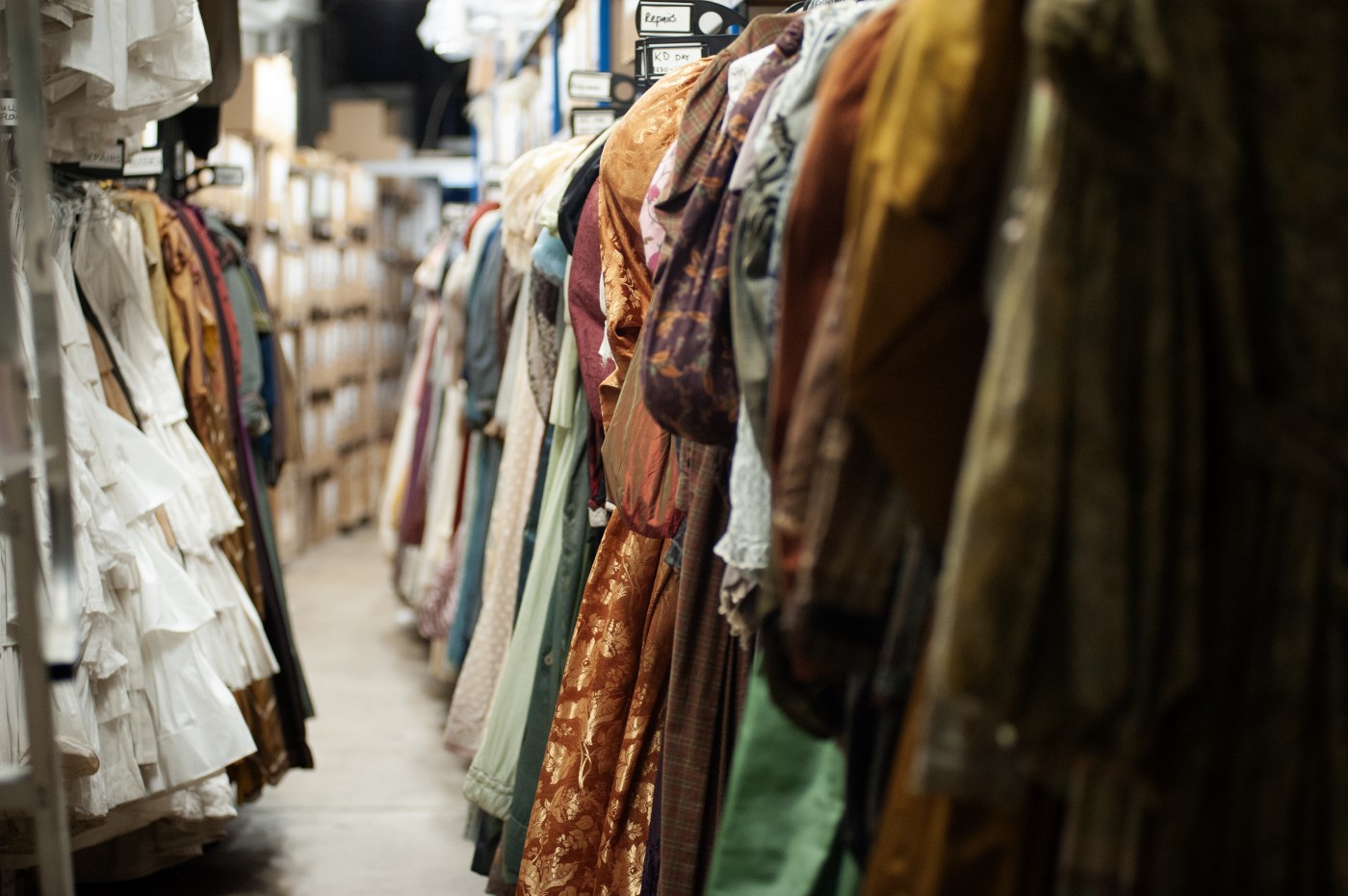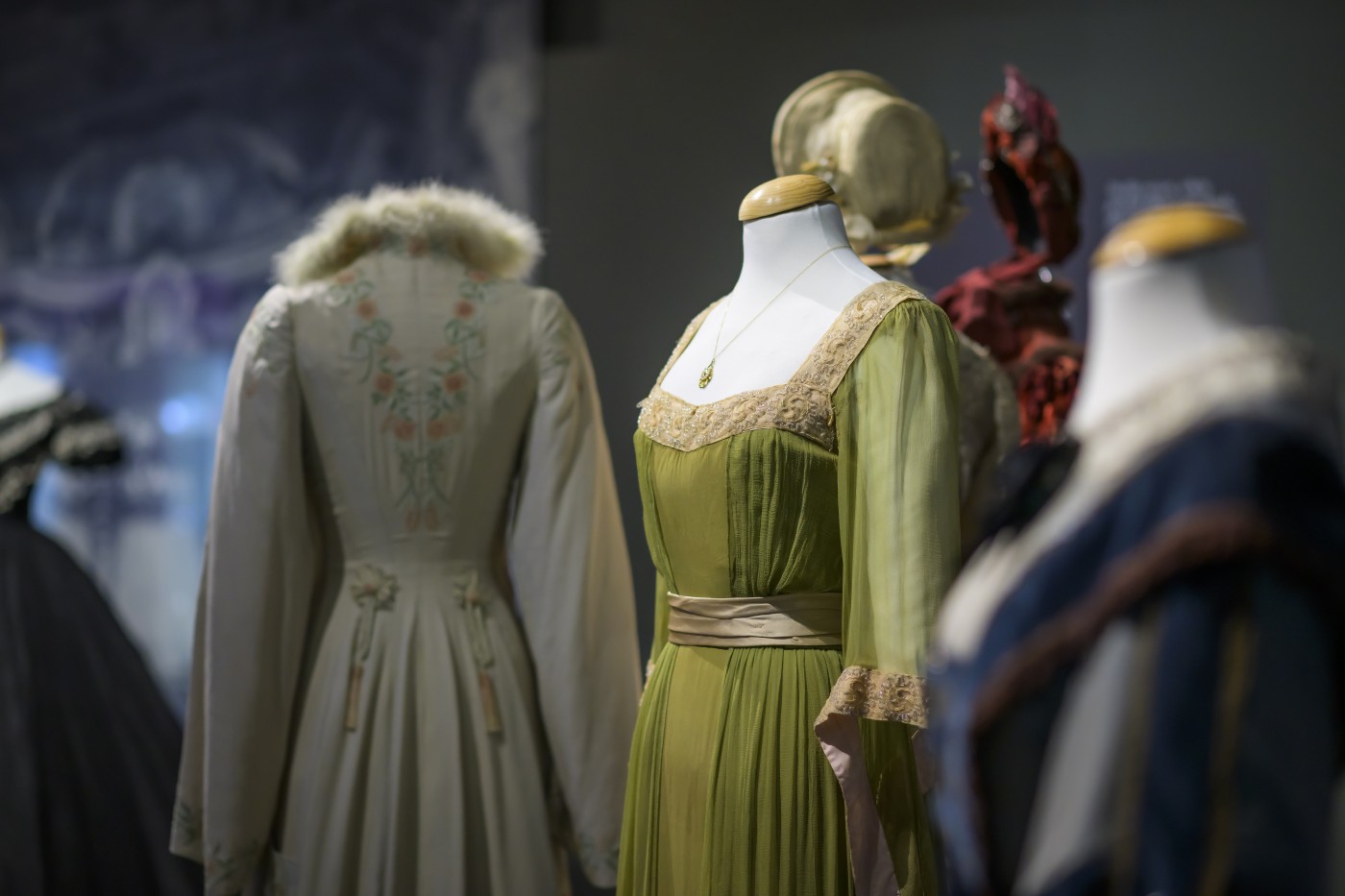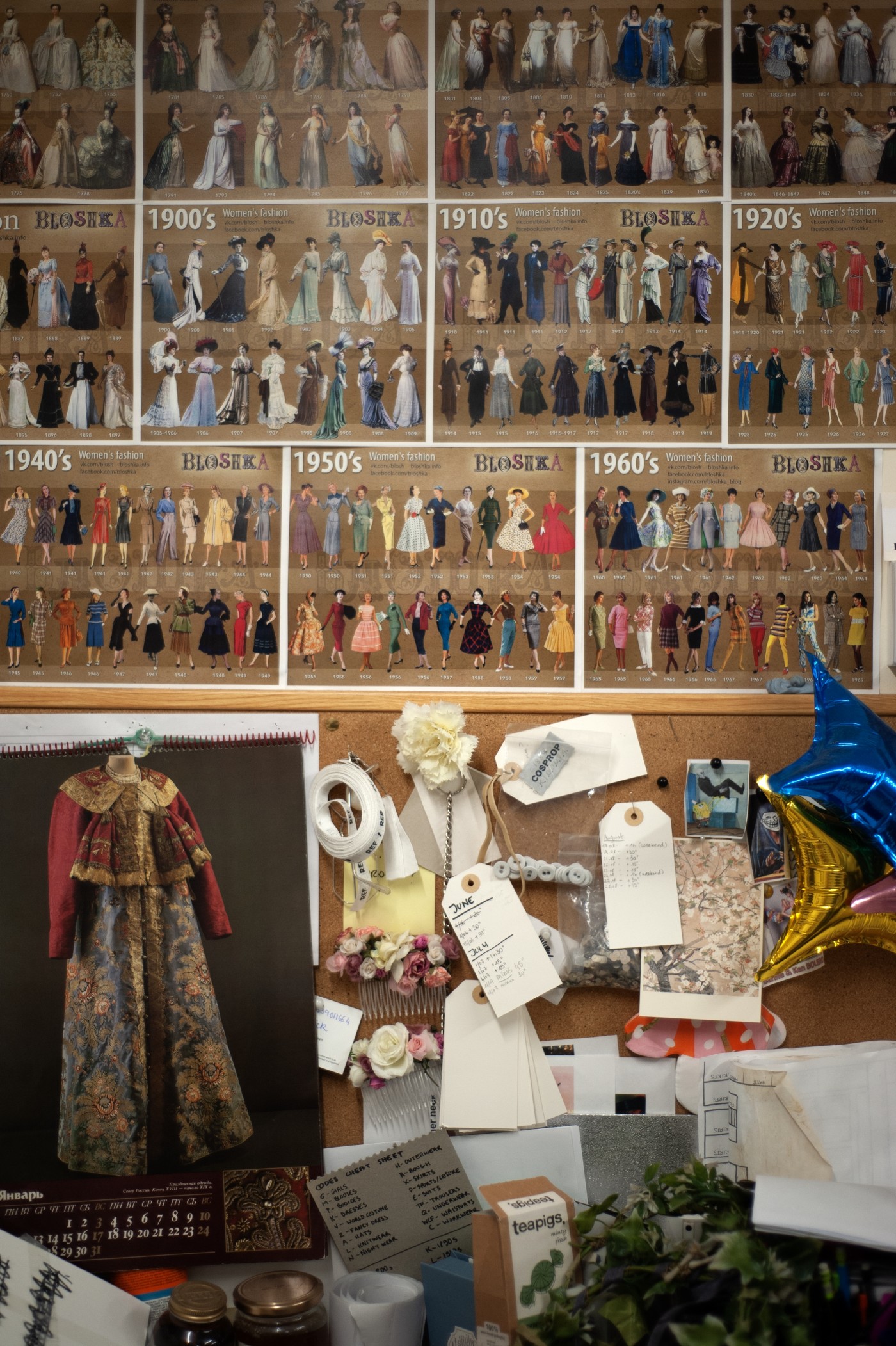- youtube
- bluesky
- Home
- About
- Costume Journal
- Membership
- Conference & Events
- Grants & Awards
- News & Social
In this week's blog post, Costume Society member, Elise Maynard reviews Costume Couture: Sixty Years of Cosprop at the Fashion and Textile Museum, celebrating sixty years of the costume house founded by John Bright.
When John Bright founded Cosprop in 1965, his mission was clear: "I decided that if we made the stock as real as possible, it would be universal. The truth is the truth for all times". This exhibition, co-curated by Bright and Keith Lodwick, offers a rare opportunity to see that philosophy made material through over 80 costumes, many of which have never been exhibited to the public before, including costumes from A Room with a View (1985), Onegin (1999) and Peterloo (2017).

The Stock Room at Cosprop © Paul Bulley
While marking Cosprop's 60th anniversary and running alongside two auctions at Kerry Taylor’s – Live Cosprop and Cosprop- The Sequel - auctioning character costumes from the house, it arrives at a moment when AI and digital effects increasingly transform what audiences see on screen. Many of the costumes are complemented by quotes in the accompanying book from Bright or designers such as Jenny Beavan, Alexandra Byrne, Anthony Powell and Milena Canonero, underscoring the human connection and collective memory which created the costumes on display. The exhibition makes a quiet but clear argument for the necessity of human craft; these costumes are not only visually spectacular in their own right; they are the tools needed by actors to inhabit their characters.
For costume enthusiasts and practitioners, the Fashion and Textile Museum provides an ideal setting. The museum's dedication to textile heritage and making processes aligns perfectly with Cosprop's ethos, creating a space where period costume craft can be examined closely. Stepping into the first room, visitors encounter audio of Bright himself discussing Cosprop's founding, an intimate beginning that sets the tone for a deeply collaborative story. The first garment on display reinforces this origin story: a distressed 1820s wedding dress for Miss Havisham. This was the first dress made by Cosprop for television. It's a poignant reminder that Cosprop began with genuine passion for historical dress, a love that has remained central to the practice throughout its sixty years.

Costume Couture © Fashion and Textile Museum
Rather than positioning Bright as sole auteur, the exhibition reveals the costume house as collective endeavour. The show unfolds across six chronologically arranged spaces, from 'Cosprop and the Golden Age of the Costume Drama'; and 'Creating Character and Period'; to 'New Frontiers: Cosprop in the Digital Age'; and 'John Bright's Legacy: The Bright Foundation', documenting how the house's collaborative approach shaped its enduring cultural impact.
Co-curator Keith Lodwick explained in an interview with Studio International how Cosprop became central to the shifting perceptions of historical costume design: “the Merchant Ivory films of the 1980s and 90s raised the standard of the period adaptation on to a new level. These films were hugely influential... The stock at Cosprop and the making skills of the staff all contributed to the visual identity of these films – we watch the characters at the centre of the cinematic frame, so everything a character is wearing will tell us so much information about the person they are”.
The curatorial decision to provide each visitor with a detailed booklet containing information about each item instead of individually displayed plaques proves inspired. With no wall text in the gallery, costumes stand uninterrupted. Visitors are invited to look first, drawn by recognition or detail, before consulting the booklet for context. The atmosphere feels almost spectral, Mr Darcy's shirt, Karen Blixen’s weathered boots, Violet Crawley’s glittering gown all carry their characters presence. As Bright highlights how actors leave Cosprop with their “character forming in their mind, having brought him or her to life through the angle of a hat, the fabric of a coat or the feel of a pair of shoes.” The costumes are mounted with character, some taking on postural gestures that imply the actor’s body within the fabric. They seem haunted with the characters they once evoked.
The exhibition also demonstrates how costume builds narrative through transformation. Isabel Archer's progression in The Portrait of a Lady, portrayed through Nicole Kidman's increasingly elaborate and restrictive clothing, traces her journey from young heiress to oppressed aristocrat, a visual arc that speaks as powerfully as dialogue.
The exhibition showcases costumes alongside costume bibles, fitting photographs, and design sketches, materiality meeting methodology. There are also mounted screens, showcasing the costumes in motion as well as in their intended design contexts. The final room is dedicated to the different skills of the makers and the intricacies involved in the process of costume production, which requires over 40 experts, each of whom play a part in the process. In many cases the production of these garments requires costumiers to use the same methods that period seamstresses and tailors would have employed, resulting in costumes that are 'breath-taking in their beauty, refinement and attention to detail'. Large-scale photographs of Cosprop's hire house interior, that are printed directly onto walls, prove especially effective. Detailing the makers at work and rails crammed with costumes, suggesting the vast repository from which these pieces emerged.
Lodwick described how, in making the exhibition, "working with the staff at Cosprop, I came to understand how the costume-making process works, how each department in the costume house collaborates with each other to produce a single costume, the length of time it takes and the attention to detail that is applied to every single project".
The exhibition balances Bright's personal design work with Cosprop's broader collaborative output. His creative partnership with costume designer Jenny Beavan is highlighted, demonstrating how the hire house model fostered artistic relationships. Behind-the-scenes material from high-profile productions offers insight into the hiring process, demystifying how costume houses operate.

Behind the Scenes at Cosprop © Paul Bulley
The final room anchors the exhibitions collaborative spirit. Footage from Bright's films, including Costume (1977), plays alongside static images from inside the Cosprop store. One wall features photographs of the people behind the costumes: makers and pattern cutters whose names rarely appear in credits. It's a pointed reminder that Bright's artistry depended on many hands, and a clear celebration of their instrumental work.
For aspiring costume designers and makers, this exhibition is essential viewing. It is a true celebration of the process, the research, making, maintenance and collaboration. In doing so, it makes a quiet argument for costume as craft deserving recognition alongside its most famous wearers.
Costume Couture: Sixty Years of Cosprop runs until 8 March 2026 at the Fashion and Textile Museum, 83 Bermondsey Street, London SE1 3XF